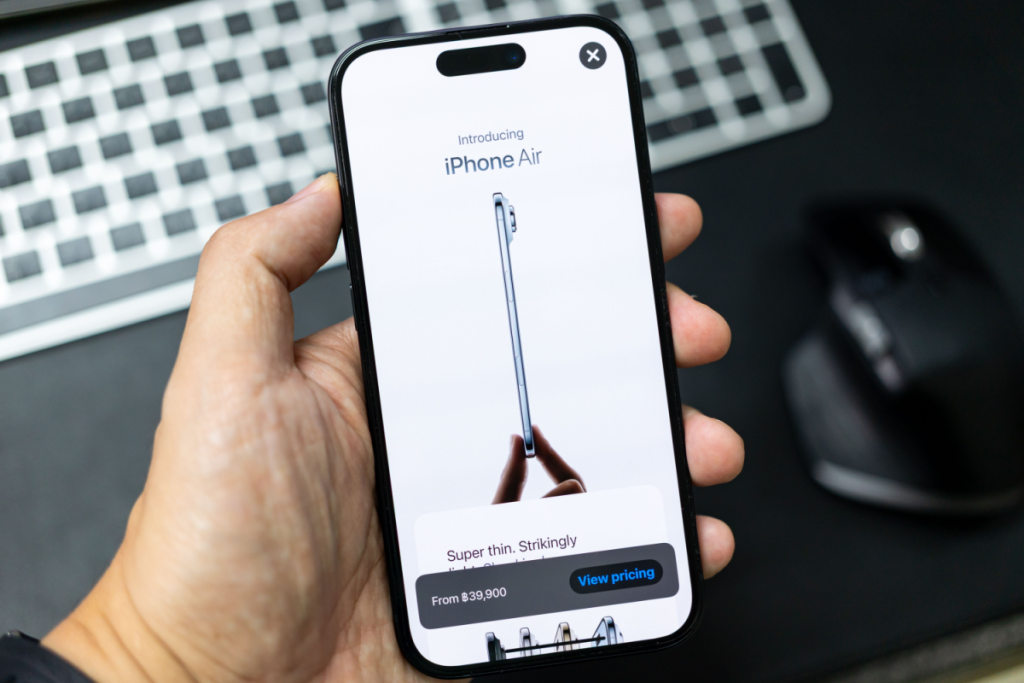The thinnest iPhone yet
Apple has introduced the iPhone Air, described as the thinnest phone the company has ever produced. Priced at 799 dollars, the device’s main appeal lies in its reduced size and sleek design rather than major technological breakthroughs. While Apple presents the Air as a refined evolution of its product line, critics argue it reflects the industry’s fixation on minimalism, offering less physical presence while amplifying the digital chaos of modern life.
For years, Apple’s iPhone updates have been incremental. The Air highlights the paradox of today’s consumer electronics: products that look simple and calm on the outside but serve as gateways to a constant stream of notifications, information and stress. The fascination with how little there is in the new design has triggered a wider conversation about what minimalism means in technology and culture.
From colorful iMacs to bare designs
Apple was once known for bold, playful design choices. The colorful translucent iMac desktops of the late 1990s were celebrated as cultural icons as much as functional machines. They stood in stark contrast to the gray, industrial PCs of the time, showing that technology could be expressive and visually appealing.
The iPhone line, however, has followed the opposite trajectory. The Air represents Apple’s continued embrace of stark minimalism. Clean edges, muted colors and a focus on disappearing into the background dominate the design language. For many, this is sophistication. For others, it signals the erasure of design character in favor of sterile uniformity.
Design analysts note that minimalism has become a new status symbol. It projects restraint and control, while concealing how deeply consumers rely on the very devices that appear so spare and calm. The thinnest iPhone yet is a reminder of how Apple uses design not just to deliver technology but to shape cultural expectations.
Minimalism across culture
The launch of the iPhone Air coincides with broader cultural trends. Scandinavian-inspired interiors, pared-down fashion lines and muted aesthetics dominate popular culture. Minimalism has become shorthand for taste, wealth and refinement, even when it strips away warmth and personality.
The theater world provides a striking parallel. In London, director Jamie Lloyd’s revival of Evita presented the musical against an almost empty stage. Stripped of historical detail and lavish costumes, the production divided audiences. Some praised its bold modernism, while others felt it robbed the story of its cultural and emotional depth. This reflects the wider debate over whether minimalism enhances meaning or drains it away.
Television, too, has echoed this aesthetic. The HBO series Succession used cold interiors and clean lines to illustrate the emotional distance of the ultra-rich. Restaurants, fashion houses and art galleries similarly favor sparse designs that signal luxury through restraint.
Minimalism as control
Critics argue that minimalism is not simply an aesthetic but a form of control. By stripping away context, it creates the illusion of order in a turbulent world. The iPhone is a perfect example: its sleek exterior conceals the constant chaos of digital life inside. Notifications, alerts and endless scrolling pour through a device that looks pristine and harmless in the hand.
This tension between calm design and chaotic function is what makes the iPhone Air more than a technological story. It is also a cultural statement about how modern society manages anxiety and information overload. Minimalism provides a mask of control, but beneath it, the complexity of life continues unchecked.
The hollow promise of less
The debate surrounding the iPhone Air underscores a larger question: does less always mean more? Apple’s focus on thinning its flagship device suggests that refinement alone can be sold as progress. Yet many consumers feel that extreme minimalism erases joy, character and humanity from design. The same critique applies to minimalist architecture, interiors and art, which often leave people with spaces that feel cold and impersonal.
In the case of the iPhone, the Air may represent peak minimalism: a sleek shell housing a device that dominates daily life more than ever. Its form may be thin, but its cultural weight is immense. For critics, this contradiction highlights the limits of design that subtracts too much, leaving objects and experiences hollow.
Minimalism promises calm and control, but in practice it may only disguise how little control we have. The thinnest iPhone yet is not just a product launch, but a reflection of the aesthetics and anxieties of the digital age.


